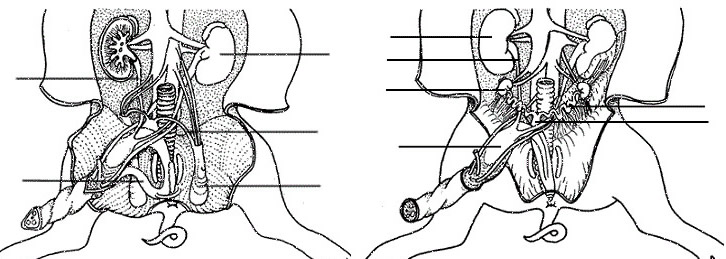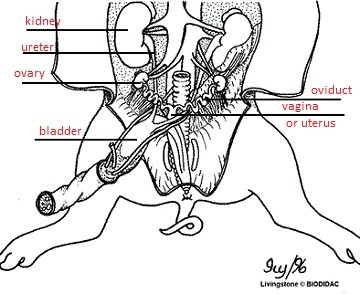
Tie a piece of string or twine around the wrist of one forelimb. Place the pig on its back in the dissecting tray. Locate the following structures and label them on the diagram below: tongue, teeth, nasopharynx, glottis, epiglottis, hard palate, soft palate, salivary glands, and the opening of the esophagus. Using your scissors, cut the corners of the jaw so that the mouth will remain open. The pharynx is the cavity in the back of the mouth - it is the junction for food (esophagus) and air (trachea).

#Pig dissection diagrams skin
Does the fetal pig have teeth? _ Are humans born with teeth? _ Locate the epiglottis, a cone-shaped structure at the back of the mouth, a flap of skin helps to close this opening when a pig swallows. Locate the esophagus at the back of the mouth. Can you feel your own hard and soft palates with your tongue? Note the taste buds (also known as sensory papillae) on the side of the tongue. (Image 4: Open mouth: Cut and paste into the left-side of your IntNB, and label during dissection) Open the pig's mouth and locate the hard and soft palate on the roof of the mouth. The salivary glands kind of look like chewing gum, and are often lost if you cut too deeply.ħ. (Image 3: Lateral view of pig’s head with salivary glands exposed: Cut and paste into the left-side of your IntNB, and label during dissection) Carefully lay the pig on one side in your dissecting pan and cut away the skin from the side of the face and upper neck to expose the masseter muscle that works the jaw, lymph nodes, and salivary glands. Does it seem well developed? Do you think pigs are born with their eyes open or shut? _ 6. Observe the eyes of the pig, carefully remove the eyelid so that you can view the eye underneath. This is not the actual dissection of the body cavities, and the pig does not have to be tied to the dissection tray for these steps, but it is very important that you follow proper lab procedure during the following observations. The following steps, 5, 6 and 7 require some incision. How many toes are on the feet? _ Do they have an odd or even number of toes? _ CAUTION: Dissecting implements are very sharp. 11mm - 21 days 17 mm - 35 days 2.8 cm - 49 days 4 cm - 56 days 22 cm - 100 days 30 cm - birth How old is your pig? _ (Record this in your IntNB) 4. The length of the fetal pig can give you a rough estimate of its age. Gestation for the fetal pig is 112-115 days.

In addition, you'll need to know the following terms: Medial: toward the midline or middle of the body Lateral: toward the outside of the body Proximal: close to a point of reference Distal: farther from a point of referenceģ. (Image 2: Lateral view of fetal pig: Cut and paste into the left-side of your IntNB, and label during lecture) Make sure you are familiar with terms of reference: anterior, posterior, dorsal, ventral.

Both males and females have rows of nipples, and the umbilical cord will be present in both. If your pig is female, you should also note that urogenital papilla is present near the genital opening.

On males, the opening is located near the umbilical cord. On females, this opening is located near the anus. Determine the sex of your pig by looking for the urogenital opening. **Make sure you know the locations of all the bold words on this handout** 1. Fetal Pig Dissection: Anatomy and Physiology External Anatomy


 0 kommentar(er)
0 kommentar(er)
